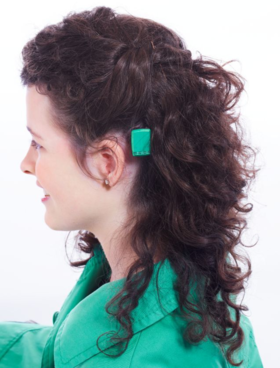
Back Prothèse auditive à ancrage osseux French Apparecchio acustico ancorato alle ossa Italian BAHA Japanese Botverankerd hoortoestel Dutch Próteses auditivas osteointegradas Portuguese Baha (implantat) Swedish
| Bone-anchored hearing aid | |
|---|---|
 A BAHA user with a sound processor attached behind her ear | |
| Other names | Bone-anchored hearing device[1] |
A bone-anchored hearing aid (BAHA)[2] is a type of hearing aid based on bone conduction. It is primarily suited for people who have conductive hearing losses, unilateral hearing loss, single-sided deafness and people with mixed hearing losses who cannot otherwise wear 'in the ear' or 'behind the ear' hearing aids. They are more expensive than conventional hearing aids, and their placement involves invasive surgery which carries a risk of complications,[1] although when complications do occur, they are usually minor.[3]
Two of the causes of hearing loss are lack of function in the inner ear (cochlea) and when the sound has problems in reaching the nerve cells of the inner ear. Examples of the first include age-related hearing loss and hearing loss due to noise exposure. A patient born without external ear canals is an example of the latter for which a conventional hearing aid with a mould in the ear canal opening would not be effective. Some with this condition have normal inner ear function, as the external ear canal and the inner ear are developed at different stages during pregnancy. With normal inner anatomy, sound conducted by the skull bone improves hearing.
A vibrator with a steel spring over the head or in heavy frames of eyeglasses pressed towards the bone behind the ear has been used to bring sound to the inner ear. This has, however, several disadvantages, such as discomfort and pain due to the pressure needed.[4] The sound quality is also impaired as much of the sound energy is lost in the soft tissue over the skull bone,[5] particularly for the higher sound frequencies important for speech understanding in noise.
- ^ a b Banga, R; Lawrence, R; Reid, A; McDermott, AL (2011). Bone-anchored hearing aids versus conventional hearing aids. Advances in Oto-Rhino-Laryngology. Vol. 71. pp. 132–9. doi:10.1159/000323711. ISBN 978-3-8055-9700-5. PMID 21389713.
- ^ Janssen, RM; Hong, P; Chadha, NK (September 2012). "Bilateral bone-anchored hearing aids for bilateral permanent conductive hearing loss: a systematic review". Otolaryngology–Head and Neck Surgery. 147 (3): 412–22. doi:10.1177/0194599812451569. PMID 22714424.
- ^ Cite error: The named reference
Wazen2011was invoked but never defined (see the help page). - ^ Raicevich, George; Burwood, Eric; Dillon, Harvey (2008). "Taking the pressure off bone conduction hearing aid users". Australian and New Zealand Journal of Audiology. 30 (2): 113–8. doi:10.1375/audi.30.2.113.
- ^ Mylanus, E.A.; Snik, A.F.; Cremers, C.W. (1994). "Influence of the thickness of the skin and subcutaneous tissue covering the mastoid on bone-conduction thresholds obtained transcutaneously versus percutaneously". Scandinavian Audiology. 23 (3): 201–3. doi:10.3109/01050399409047509. PMID 7997838.